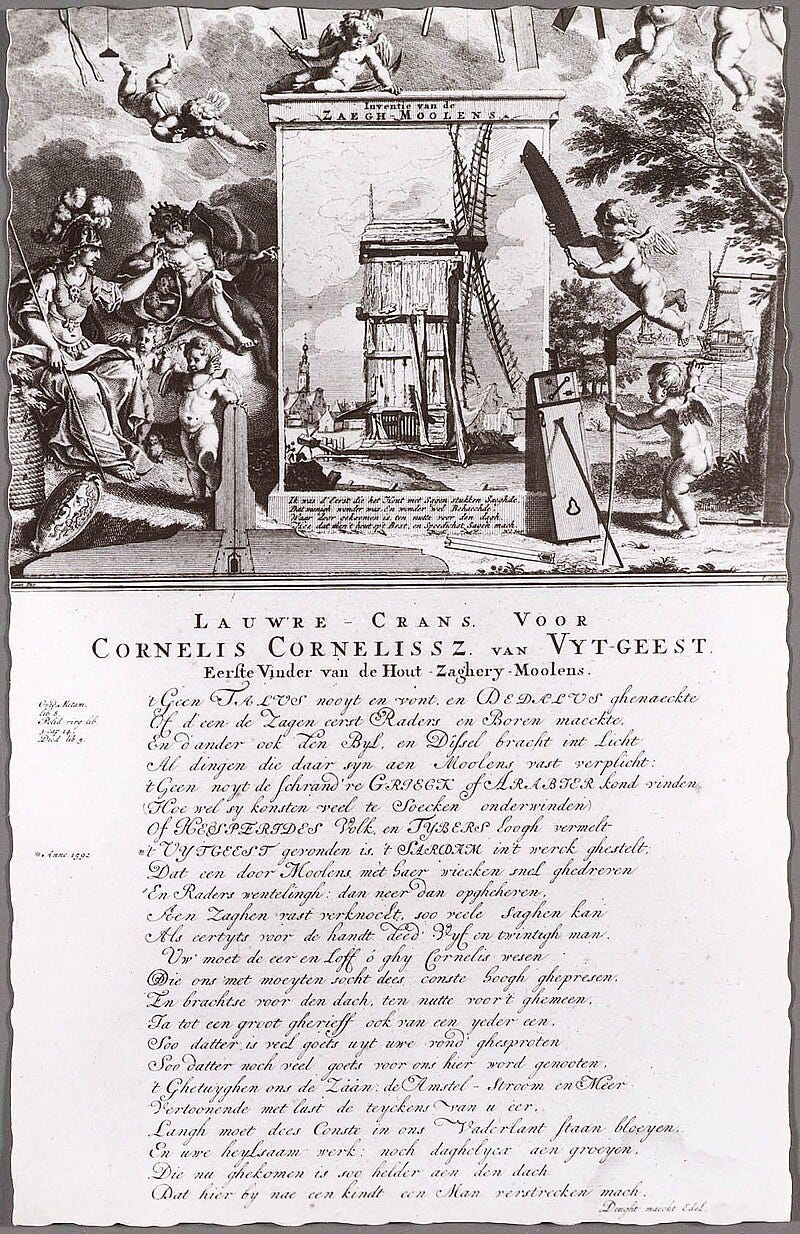TL;DR: The article explores how a seemingly minor invention, the sawmill, by Cornelis Corneliszoon van Uitgeest in 1594, significantly contributed to the Dutch Golden Age. By mechanizing wood processing, it vastly improved shipbuilding efficiency, giving the Netherlands an edge over competitors like England. This technological advancement played a crucial role in establishing the Dutch as a maritime superpower and underscores the broad impact that one innovation can have on a nation's economic and naval dominance.
As a self-taught historian with a particular fondness for European history, the tale of the Netherlands during the 16th and 17th centuries has always held a special allure for me. With a population of merely 1.5 million at the time, this small nation was continually at war with the formidable Spain under the rule of Charles V and later his son Philip II. Yet, amidst the constant turmoil, the 17th century emerged as the Dutch Golden Age—a period of unparalleled economic, cultural, and political prosperity. Many attribute this prosperity to various well-documented factors such as the migrations preceding the 17th century, the independence of the United Provinces of the Netherlands, the ventures of the Dutch East India Company (VOC), and the profound influence of the Protestant Reformation and Calvinism. However, I believe that a seemingly minor technological innovation—the invention of the sawmill by a Dutch windmill owner, Cornelis Corneliszoon van Uitgeest in 1594, played a pivotal role in catapulting the Dutch to the zenith of economic triumph, especially against formidable competitors like England and its British East India Company.
Around 1590, the Netherlands was in the midst of the Eighty Years’ War against Spain. Concurrently, the country maintained a cautious relationship with Elizabeth I’s England, which was also unfriendly towards Catholic Spain. This era was a melting pot of religious, political, and economic tensions, necessitating ingenuity and innovation.
Cornelis Corneliszoon van Uitgeest , a modest Dutch windmill owner from Uitgeest, was the mind behind the revolutionary sawmill invention. His effort was not just a playful try, but a practical invention driven by need, which would greatly help the nation's economy. The genius of Corneliszoon lay in his ability to translate the circular motion of windmill vanes into an up-and-down movement, enabling the mechanized sawing of logs. This innovation exponentially increased the rate at which wood could be processed, setting the stage for a surge in shipbuilding and other wood-based industries. Corneliszoon’s invention was duly recognized by the authorities, and he was granted a patent for his sawmill.
The invention of the sawmill by Cornelis Corneliszoon van Uitgeest significantly transformed the timber industry in the Netherlands. His invention expedited the conversion of log timber into planks, making it 30 times faster than previous methods. This was a remarkable leap from the traditional manual methods where boards were sawn by two men with a whipsaw, which was a slow process requiring substantial physical effort.

Which can be translated approximately into English as follows:
First inventor of Wood-Sawing Windmills.
...
No magician ever discovered, and even Oedipus came close,
None made the first saws, gears, and drills:
He searches and finds, bringing innovations to light.
All these achievements, thanks to windmills' might.
Wherever there were few people or undeveloped lands,
He pulled knowledge from afar, with skilled hands.
Using farmer's tools and daring techniques,
What Uitgeest discovered, he surely perfects.
Using sharp tools with precision and grace,
His windmill innovations found their place.
One of the earliest instances of adopting this invention can be traced back to the town of Zaandam, where Cornelis built the first sawmill known as "Het juffertje" or "The missy" in 1596. The adoption of this technology saw a significant rise over the years. By 1630, a substantial number of sawmills, 83 to be precise, were operational north of Amsterdam, showcasing a rapid adoption of this innovative technology within a span of just 34 years.
The innovative hull design of Dutch ships, combined with the use of wind-powered sawmills, enabled the production of unprecedented numbers of ocean-going vessels for long-distance voyaging and inter-regional trade, particularly in Asia. This was a significant factor in the Dutch's success in 17th-century world trade, as they could build ships that were not only numerous but also large and robust enough for extensive sea voyages, like those to Southeast Asia.
The wind-powered sawmills allowed for efficient processing of wood, which was critical given the wood shortages experienced in the 17th century. During this time, the Dutch East India Company (VOC), which became the world's first multinational trading enterprise, built a total of 706 ships in the Netherlands' shipyards.
When comparing Dutch advancements to English shipbuilding, it's notable that the Dutch East India Company's use of sawmills for shipbuilding gave them an edge over their English counterparts. The English shipbuilding industry did not adopt sawmill technology until much later, which meant that for a significant period, the Dutch could build ships faster and more efficiently than the English could. This advantage was critical in the context of the intense commercial and naval rivalry between the two nations. The sawmill innovation, therefore, played a fundamental role in the Dutch maintaining their superiority at sea, which was a central pillar of their Golden Age.
The seemingly minor innovation of the sawmill by Cornelis Corneliszoon van Uitgeest, played a colossal role in shaping the commercial and naval dominance of the Netherlands in the 17th century. By significantly enhancing timber production, it fueled a shipbuilding surge that was instrumental in establishing the Dutch as a maritime superpower. This tale underscores the profound impact that a single technological advancement can have on the fortunes of a nation, propelling it to the pinnacle of economic and naval dominance. It showcases how the creative solution of one individual can align with the needs and opportunities of their time to spark an era of unparalleled prosperity, as seen in the Dutch Golden Age.





Thank you! 🙏